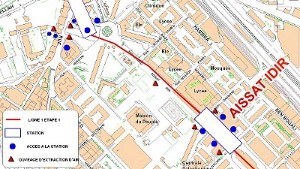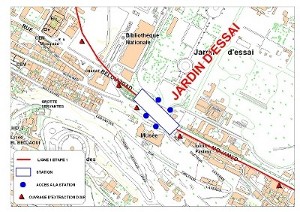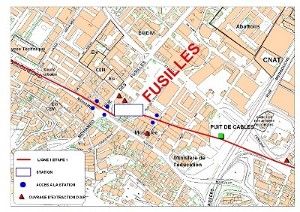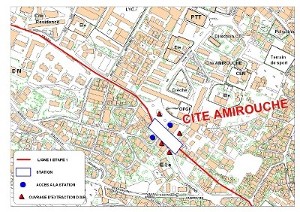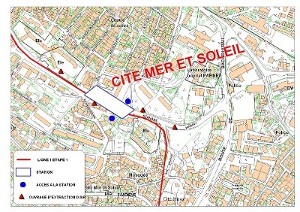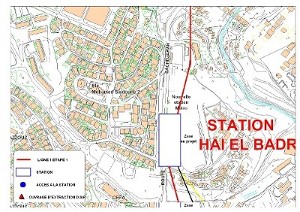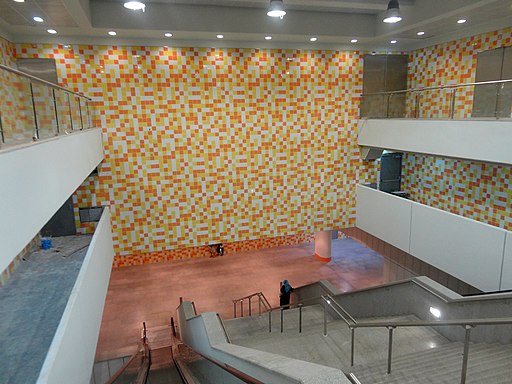It is the underground transportation system that serves the City of Algiers, capital of Argelia. Currently, Algiers’ Subway System has only one line in service which is 13.5 kilometers long. There is an additional line under construction. It is one of the newest subways in the world. It was inaugurated in 2011, its planning dates from 1980, though. Its only line has fourteen stations and most of the tracks run underground. The base fare is 50 dinars (0.45 US$). The operation hours are from five in the morning till eleven at night, functioning continuously throughout the year. Although the schedule changes during the month of Ramadan.
Subway Systems in Argelia: Algiers
Algiers is the capital of The People’s Democratic Republic of Argelia, a Mediterranean country located in the North of Africa. It is situated on the shores of the Mediterranean Sea, on the north coast of the country which provides a privileged frontal position towards Europe. Also, it is the most populated city in Argelia with more than two million inhabitants. More than 4, if we add the ones on the metropolitan area. The city finds one of its greatest attractions on its architecture, combining the traditional Arabic construction style and the French colonial and modern styles. The temperature is warm most of the year, dropping to 10C only during winter. One of the greatest attractions of the city is the Casba of Algiers, a traditional Islamic citadel, it is unique among other countries in the North of Africa.
The Algiers Metro runs over 13.5 kilometers along de city. On the year of its opening, ten stations started to operate. In 2015 four stations more were incorporated. The system has fourteen trains with six wagons, each. Manufactured by the Spanish CAF. This trains have 108 meters of length and have the capacity of transporting 1216 persons, from which 208 go on seats located at both sides of the wagons. Based on this numbers, Algiers' Subway System can carry 41000 passengers per hour, which translates in 150 million trips with approximately 16 million passengers. The Subway is operated by the French RATP, the same company responsible for the transportation of Paris.
Short Story
Even though Algiers’ underground system is modern and recent, the system has a long story about unfinished projections and unjustified delays. From the decade of 1970, the need of an underground transportation system in the capital of Argelia was raised, which would have been an unprecedented event in the whole African continent. The first approach to a subway system proposed a track of 64 kilometers. An ambitious project for that time. The project was established on 1982. However, with the prices on the petroleum going down, it was soon discarded.
In 1998 the official construction of the “Metro of Algiers” started. In the next fifteen years only four stations were installed. Between 1994 and 1999 three stations were added. By 2003 the government of Argelia developed an agreement with international enterprises for the final completion of Algiers Metro Project. The agreement involved Vinci, CAF, Siemens and finally RATP which operates the system, currently. On November 1st, 2011, the first line was opened with ten stations and by 2015 another section of the track with 4 stations opened as well.
Lines and stations
The Subway of Algiers, currently, has only one operating line. Another one is under construction. The operating line, has fourteen stations that cover 13 and a half kilometers. The system runs throughout seven communities in Algiers, from the Downtown area to El Harrach, boarding the coast. From the ten stations that were opened at the beginning, nine are completely underground, only one of them, Hai El Badr terminal, is a station at surface level.
The stations have two main lanes, separated by two platforms of 115 meters of length. This way, the station Hai El Badr makes a difference, also. It has three platforms from which the trains can be accessed. Most of the stations have been designed under universal accessibility standards, providing autonomy to its users. The stations are: Tafourah – Grande Poste and Khelifa Boukhalfa, from Algiers’ Downtown commune; 1st Mai and Aissat Idir from the Sidi M’Hamed commune, Hamma and Jardin d’Essai from the Belouizdad commune: Le Fusilles, Cite Amirouche, Cite Mer et Soleil at Hussein Dey; Hai El Badr at El Magharia; Bachdjarah – Tennis and Bachdjarah belong to the Bachdjarah commune: El Harrach Gare at Bourouba and finally, El Harrach Centre Station located at El Harrach.
La Grande Poste station:
La Grande Poste is located in Algier's center of the city. It's the intersection of all the routes that cover the main places in the city: Place des Martyres, Audin Place, Algier's University, Tafourah bus station an the Wilaya of Algiers. This station has the biggest passengers transit as it is the beginning of the line and it's near of many places of interests for the turists. In the future, this station will have a direct conection with Algier's underground line 2.
Khelifa Boukhalfa Station
Khelifa Boukhalfa station gets to Algier's commercial area, Mourad Didouche street, Cinema Argelia and Victor Hugo Street. Some other important places around this area are: Hassiba Ben Bouali, Meissonier Market, the Sacred Heart and Liberty Park.1er Mai Station(May 1st)
This station is located in Mokrani. It's connections with bus and taxy(ETUSA) networks. It gets to Mustapha Bacha Hospital and to the Mohamed Belouizdad (Belcourt) district, one of the oldests in the city.
Idir Aissat Station
Aissat Idir is found in Belcourt's heart. This station is near Maison de la Presse, bus stops, Telecom Argelia and UGTA headquarters. It is located in a strategic place to relieve the congested road network of its traffic.
Hamma / Jardin d’essais Stations
Hamma and Jardin d’essais stations. They cover the National Library of Hamma, Sofitel Argel, Jardin d'Essais, Pasteur Institute areas.
Les Fusillés station
This station is reacheable from almost everywhere (Brook, Kouba, Hussein Dey and Bir Mourad Rais...). It'll be the real communication center where underground, trams, buses, taxys and funicular will converge.
Amirouche Station
It is locatet in the intersection of Hussein Dey and Kouba districts.
Mer et Soleil (Sun and Sea) station
Mer et Solei station is western side of line 1. This is the heart of the residential area Mer et Soleil, next to Hussein Dey.
Hai El Badr Station
It is in Hai El Badr district and covers Panorama y Hussein Dey, Ben Omar and El Kouba Cadat and Bachdjarah. It is a link between Algier suburban areas and offers a fast, comfortable way of moving around the city.
Connections with other systems
As the Subway of Algiers is system created recently, the articulation with different transportation systems hasn’t been completely achieved. However, Algiers is developing a transportation system inspired in the Parisian style and this is possible given the fact of a direct French intervention from the operator RATP.
Besides Argeli’s Subway System, there’s a trolley operating in the city. A modern way of transportation that runs along 16.2 kilometers, from the east side of the Bay of Algiers to the west side, where it is the only operating massive transportation system.
Its conection with Algiers’ Subway is located in Les Fusilles station, where it connects with the trolley station of Ruisseau. The trolley is operated by RATP and there are ticketing systems that work for both, the Subway and the Trolley, designed specifically for those whom have to move from side to side of the city.
Les Fusilles station also conveys with another system, only present in some isolated parts of the city of Algiers. The Cable Railway. It represents one of the oldest method of transportation in the city, dated since 1956. There are five cable railway lines in Algiers: The Madania, Memorial, Culture Palace, Notre Dame of Africa and Triolet. Furthermore, it is under construction the Bab El Oued and there are two more projected. The Madania and Memorial are close to each other in the subway line, while The Culture Palace connects with Les Fusilles.
However, the busiest connection might be the nearby trains RER. Operated by the Societe Nationale des Transports Ferroviaires (SNTF), connecting the city with the suburbs. Most of the system runs parallel to the Algiers’ Subway line, without making any connection. However, it overlaps with the Trolley of Algiers. Finally, in the new station named El Harrach Gare there are a connection to the nearby system of SNTF, which splits in two directions: east and south.
It cannot be forgotten, as in every city, the bus transportation from the Entreprise de Transport Urbain et Suburbain (ETUSA) which has more than one hundred lines and a couple of public lifts.
Connections with the Airport
The Algiers’ Metro runs through very important spots of the city, with a big population and touristic attractions, a lot of passengers want to know which is the best way to arrive from the airport to the Subway of Algiers. Currently, there is no direct connection with the Subway of Algiers. However, the extension of the line 1 is under construction, which, indeed, will have as a final station the airport Houari Boumediene. There is also a new branch projected for the SNTF which will arrive directly to the airport, coming from the stations Bab Ezzouar and Dar El Beida.
Right now, the best way to access the Algiers’ Subway from the airport is by taking the bus and the trolley. Every thirty minutes, there is a bus, line 100 from the ETUSA, departing from the airport to Cite 8 Mai 1945. Right where there is a Trolley station. Through this system, a further connection with the Subway of Algiers can be made.
Schedule and Recurrence
The capital of Argelia needed a transportation system operating most part of the day and the Subway of Algiers has achieved it. This underground train works seven days a week, from five in the morning to eleven in the night. This schedule is shortened during the holy month for Islamic population: Ramadan. When this happens, the Subway of Algiers only operates from seven in the morning to one thirty in the afternoon.
The frequency for the trains is directly determined by the time, whether or not is a busy hour. During the busy hours, the wait time between trains is three minutes and twenty seconds, while during less busy hours, the wait time increases up to five minutes. The system capacity is 25000 passengers per hour. However, the number is usually a lot less. For some tourists, the Subway of Algiers have been an allied, given the fact that it is not a busy system.
Fees, tickets and cards
The fees for the Subway of Algiers have changed with time. The basic ticket was set in about 50 dinars (0.45 U$). On the other hand, the ticket that works for ten rides costs 400 dinars (3.68 US$). Since 2012, the ticketing system of the various means of transportation in Algiers has been unified, specially between the subway and the trolley. This has allowed passengers to cross from one to another with the same ticket. The fee is set in 70 dinars (0.64 US$) and the ticket for ten trips in 600 dinars (5.51 US$).
Furthermore, there is a monthly payment plan available in the system ideal for residents or tourists that want to stay for a longer period of time in Algiers. It covers the subway and the trolley, the monthly payment is 2500 dinars (23 US$). In the form of cards that can be reloaded. Students also have benefits regarding fees, with a monthly payment of 700 dinars (6.44 US$) which is reduced to 400 (3.38 US$) when is a junior high school student or younger. When it is about a combined fee for students between the subway and the trolley, the fee is 1000 dinars (9.19 US$) per month.
Rules of the System
Every transportation system has regulations that allow an optimum relationship between the passengers and the method of transportation, providing a mutual benefit. Subway operators ensure the stablished standards. Some of the rules of the Algiers’ Subway are:
- In order to access, every passenger must have a valid ticket, which can be obtained in the booths and machines located in every station.
- In all wagons and platforms at every station, there ought to be order.
- Any disrespectful behavior, that goes against other users or against any subway employee, is forbidden.
- It is also prohibited the reproduction of music in high volume and without earphones, it disturbs the trip of other passengers.
- Animals inside the subway are forbidden, except for companion animals or small animals that can be carried in purses or baskets, always handed by their owners.
Further Expansions
The construction of the Subway of Algiers advances decisively. The original project incorporates a bigger extension from the one that currently exists, which is the reason why the expansion of the Subway of Algiers is a fact.
In 2015 the second stage of line 1 of Algiers’Subway was inaugurated, with four additional stations that extended the system unto El Harrach Centre. By 2020, it is planned the inauguration of the third stage for this line, with nine additional stations, which will end in the International Airport Houari Boumediene. The stations that are under construction are: Hacen Badi, Pole Universitaire, Beaulieu, Oued Smar, Universite des Sciences et Techniques Houari Boumediene, Rabia Tahar (connection with the Trolley of Algiers), Cite Smail Yefsah Centre des Affairs and Aeroport.
In the other end of the line, in the north side next to the bay, there is also an extension with two stations under construction, which will be Ali Boumendjel and Place des Martyrs. Towards the south side, there is another section of the subway under construction, as well. With four stations, that goes from the middle of the stations Hai El Badr and Bachdjarah – Tennis. The nine stations will be Les Ateliers, Ali Naadja 1, Ali Naadja 2 and Mohamed Boudiaf.
The most relevant fact about the Subway of Algiers expansions is that most of them are already under construction. This is because the project has decades already planned and it wasn’t until some time ago that the project rapidly solidified. However, there are other projects that haven’t started yet. There is a proposal for an elevated subway system Hai El Badr – Chevalley, which is the most relevant. Also, there are other extensions projected on paper that go from stations that haven’t been finished, yet.
Advice
Safety is always a factor to have in mind. The Subway of Algiers is no different in this matter. During busy hours there can be agglomerations, this can be a paradise for pickpockets. It is highly recommended to carry personal belongings in the front pockets also, keep purses towards the front.
For tourists, there is a big language barrier. Arabic is the national language of Argelia, the reason all users should understand standard Arabic. Although, they probably answer to a dialect variant. Furthermore, since Argelia was a French colony, a big part of the population understands French as a lingua franca. Also, some berber idioms can be heard here and there, there are people communicating in English as well. It is recommended for tourists to use a language they understand (a little) and be patient.
In the aim of avoiding suspicion for terrorism, it is very important that every user of the subway carry their own purses, backpacks and bags. Any purse that gets identified as abandoned is a threat and would turn on all the alarms in the subway. This kind of misunderstanding can be easily avoided by carrying personal belongings and not disturbing other users.
Interesting Facts
- It is the second subway system inaugurated in the African continent, just after the subway of El Cairo in Egypt, opened to the public in 1987.
- It is the first subway system that is planned in the People’s Democratic Republic of Argelia. In 2020 the subway in Oran will be opened to the public, which is now under construction.
- During the excavations for its construction there was an amazing discovery. An archeological treasure which dated from the time when Argelia was part of the Roman Empire was found. Among the discoveries, there was a public building and a byzantine necropolis from the VII century.
- Parts from the Es Sayida Mosque were discovered as well, built by the Otoman Empire and destroyed during the French colonization in the XIX century.
Sightseeing from the Subway of Algiers
Algiers’Subway was built from the city’s downtown area, in the Mediterranean Sea bay, intended for tourists that want to know the city. Some of the hot spots the subway stops at are:
- Grande Poste Plaza: Getting off at the station Tafourah – Grande Poste located in the downtown area is an icon of the city. Next to the plaza there is an emblematic building: The Grande Poste Building, in other words; the post office. The architecture of the building is neomudejar, it is the heritage from the period of the French colony.
- D’Essai Gardens and Monument to the Martirs: Getting off the station D’Essai Gardens there is a nice green area, from which the cable railway will take you to the Monument of the Martirs, an imposing figure at the top of the hill, the Army Museum and a Mirador of the city are located there as well. In the lower part there is the D’Essai Gardens, which were gardens created by the French to import some species of vegetables from their colonies in the five continents.
- Boulevard Zighout Youcef: Getting off at Tafourah – Grande Poste station. Going a few blocks up, heading to the sea, there is an interesting boulevard, it has been designated as a leisure space where the architecture can be appreciated from one side and the marine landscape from the other. Going further up, there is the Casba of Algiers.
Algiers metro map
- Passengers/Day
- Fares:
- 24h operation: No
- Air Conditioning: Yes
- Walk between platforms: Yes
- Driverless trains: No
- Screen Doors Platforms: No
- Max. Speed: 70km/h
- Operator: Régie Autonome des Transports Parisiens (RATP)- El Djazaïr
- 1.40 EURO
- Algiers Metro Official Website
Help us
If you consider that the information we provide is wrong, not accurated, outdated, translation contains errors, and you would like to help us to improve the file...you can contact us here.
Feel free to contact us if you dont find the system you're looking for and we'll add it as soon as we can!
Thank you very much!











